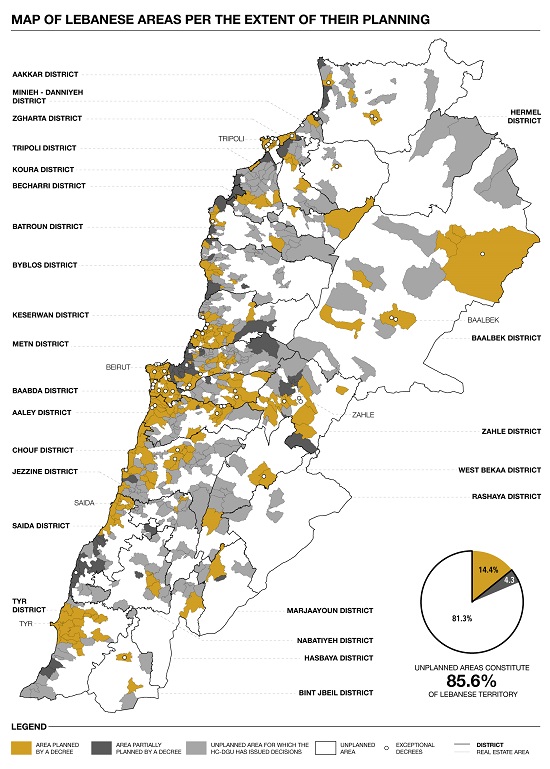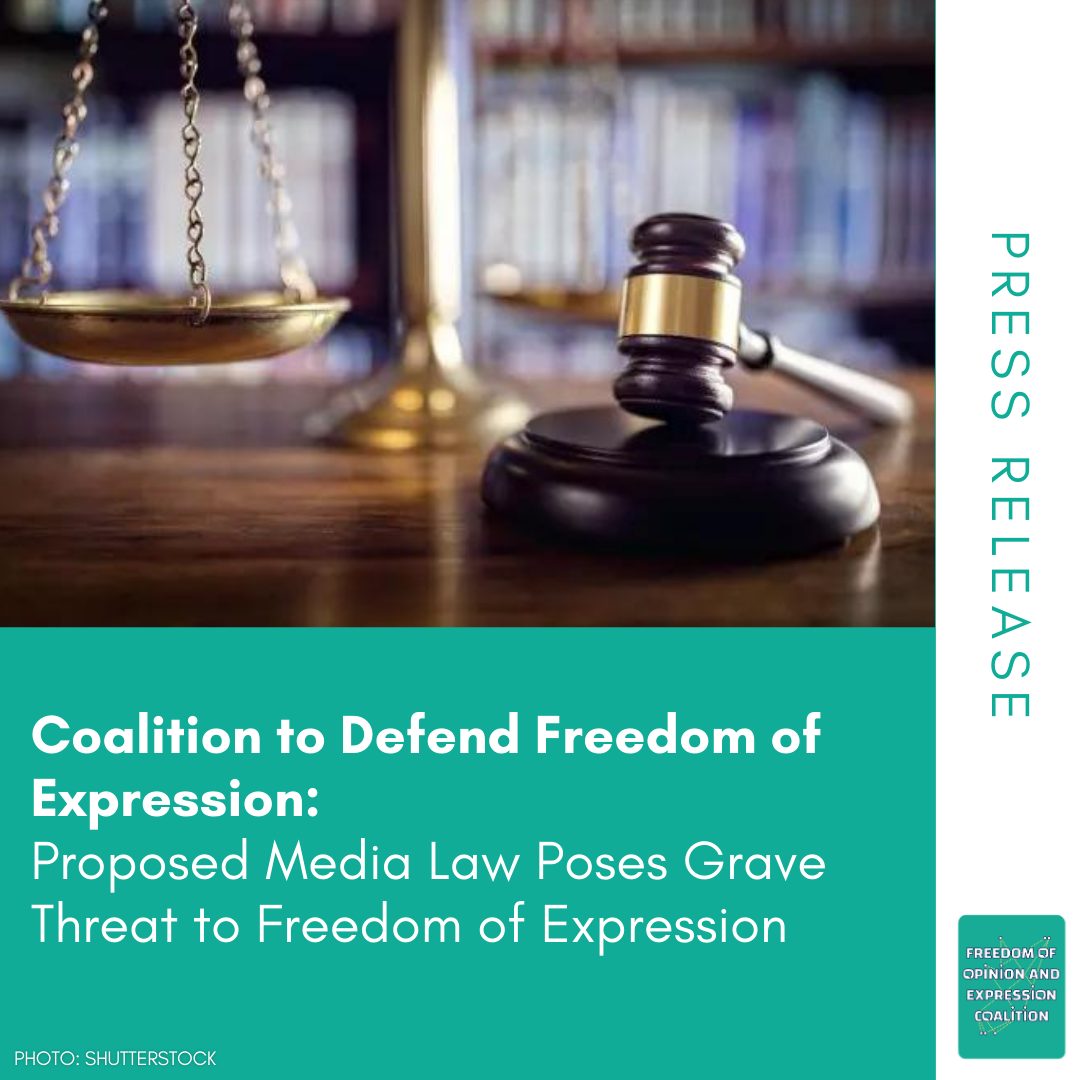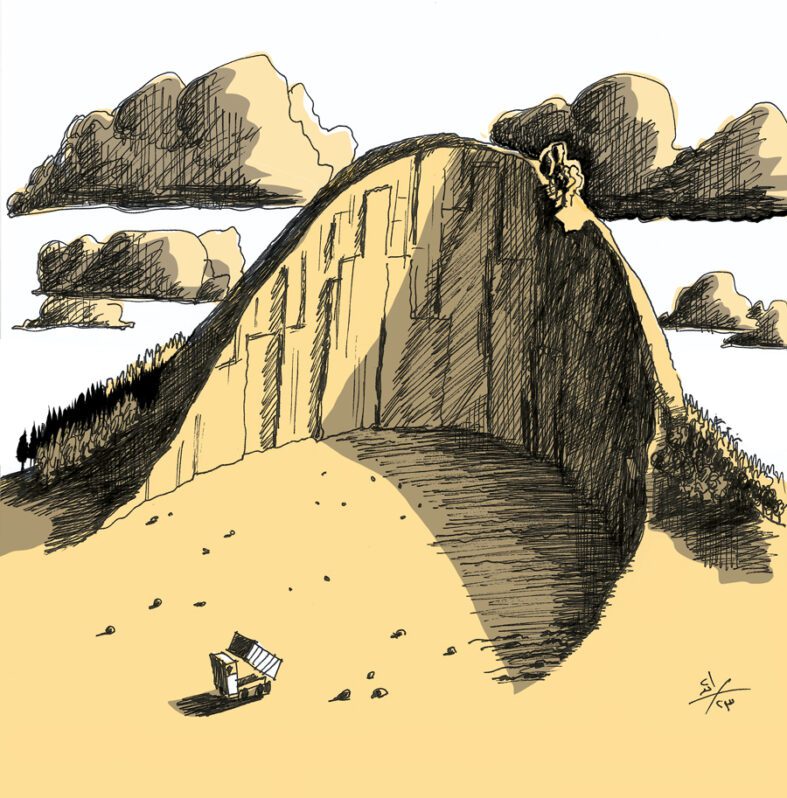The General Directorate of Urban Planning: Arbitrary Practice Between the National Master Plan, General Master Plans, Exceptions, and Decisions

In a previous article, we analyzed the current legislative framework for urban planning in Lebanon. We found that it lacks a process of informing and involving the people before the plans and regulations are issued, which exacerbates the power of “decision-making circles” that are constrained to personal relationships, revolve around the landowners, and pave the way for the rise and spread of nepotism and clientelism.[1]
In this article, we approach urban planning from the angle of practice. If the general master plans and detailed regulations set the principal use of the land and the construction conditions in light of public interest, then what portion of Lebanese lands are planned? In which periods were they planned? What political and legal factors contributed to the issuance or non-issuance of general master plans for particular areas? From another angle, are these plans adhered to as a regulatory framework not open to exceptions? What about the areas that are still unplanned?
To answer these questions, we conducted detailed research in the archive of the Official Gazette and in the records of the Lebanese University’s Center for Study and Research in Development and Planning.[2] Based on this information and data, we produced diagrams and maps that allowed us to derive lessons and conclusions about the practice of the public administrations for urban planning.
Conclusion One: 85% of Lebanese Territory is Unplanned
Based on a database of all general master plans ratified by decree issued since 1954, we have plotted a map showing the extent to which Lebanon’s various areas are planned. The areas have been classified as follows:
- Areas for which comprehensive general and detailed master plans have been issued. In other words, the plans cover the entire administratively defined geographical area concerned. We deemed that this group constitutes Lebanon’s so-called “planned areas”.
- Areas for which only partial plans have been issued. In other words, the plans cover a portion of the area concerned (such as an industrial area or coastline).
- Properties (or groups of properties) in a given area that have been excepted from the general planning regulations or for which an increased exploitation ratio has been permitted in contravention of the general master plan or the Building Law.
We also added another important category – the unplanned areas for which the Higher Council of Urban Planning (HCUP) has issued decisions – because they pose an issue of arbitrary planning.
The map shows that today, unplanned areas constitute 85% of Lebanese territory, a very high percentage. The 15% of areas that are planned are mostly spread across the major cities and their suburbs, where there is dense urbanization. The areas falling in the former, larger category face arbitrary neglect exemplified by the high number of partial plans (91 areas) and decisions (353 areas) pertaining to them. A HCUP decision is binding for construction permits granted during a three-year period, by the end of which the Council of Ministers should have issued a decree ratifying it. In all these cases, the decrees were not issued within the legal time limit, which in principle renders the decisions invalid and ineffective. However, some administrations continue applying these decisions in accordance with customs that contravene the law.[3] Hence, we are systematically witnessing a senseless planning process totally adverse to public interest. This situation allows developers to carry out their projects in the complete absence of any controls.
Map of Lebanese Areas per the Extent of Their Planning

|
The number of HCUP decisions for unplanned areas rose from four between 1980 and 2002 to 15 in 2003, then to an average of 27 per year between 2009 and 2014. |
Conclusion Two: Much Planning Before the Civil War, Many Exceptions Thereafter
In order to understand the historical stages during which the planned areas were planned and the factors at play during them, we plotted a timeline showing when areas were first fully planned via a general master plan ratified by a decree. We excluded the partial master plans because we considered them incomplete planning actions.
This timeline shows the enormous discrepancy between the GDUP’s activity planning areas before the Civil War (1975-1990) and this activity after the war. In total, 82 areas were planned during the 15 years preceding the war, whereas only 28 were planned during the 15 years that followed it. The year 2005 is a pivotal point in this analysis because of the issuance of a HCUP decision on unplanned areas that lowered the permitted surface and total exploitation ratios,[4] which had been 40% and 0.8 respectively since 1971, to 25% and 0.5 respectively. We can deduce that the reduction in the exploitation ratios for unplanned areas encouraged the municipalities and the GDUP to reinvigorate the planning process to evade these stricter construction conditions. For example, during the eleven years following this decision (2006-2017), 50 areas were planned for the first time.
Regarding the exceptions, i.e. the decrees that except a property from the general regulation or permit a higher exploitation ratio, only two were issued during the 15 years preceding the war. Yet from 1990 to 2005, there were 33 exceptions, followed by 42 exceptions from 2006 to today. These numbers indicate a failure in the legislative process totally at odds with the concept of a “general regulation” or general master plan. Despite our critical position on some regulations and plans in and of themselves (a topic we will address in other articles), we object to these exceptions as they are restricted to the requests and needs of wealthy and influential landowners.
The timeline shows another pivotal date, namely the issuance of the National Physical Master Plan of the Lebanese Territory (NPMPLT) in 2009. The NPMPLT was based on a series of goals and values, the most important being the equitable development of regions, optimal use of natural resources (especially water), reducing state expenses, improving economic productivity, social development, and conserving the environment. The ministries, administrations, and municipalities must adhere to the NPMPLT’s directions in all aspects of their work related to land planning and construction. Decree 2366 specifies in its tenth article, which pertains to applying the NPMPLT, that the HCUP’s president must form a committee to “follow up the implementation of the NPMPLT and develop it”, which never occurred. Responsibility for this failure falls, in particular, on the HCUP’s current president Elias al-Tawil, who assumed his position in 2010.
What occurred was the opposite. Since the NPMPLT’s issuance, 42 general and detailed master plans have been ratified and 69 amended, yet only 5 of them have mentioned the NPMPLT. The rest of the decrees have not even used the NPMPLT’s vocabulary. For example, they have not discussed the network of natural landscapes, natural resources, agricultural areas bearing national importance, or areas at risk of groundwater contamination.
Today, the GDUP’s flagrant disregard of the NPMPLT, its indolence in planning areas, and its vigorous issuance of senseless exceptions and decisions results only in the recurrence and exacerbation of inequalities and the continued domination of an influential few over Lebanese territory.

|
General Directors of Urban Planning |
|
The general directors of the GDUP belong to the first class of public servants. Hence, their appointment requires the votes of two-thirds of the Council of Ministers. There are two kinds of appointments: permanent appointments (lifelong) and acting appointments (one year).
Permanent appointment provides protection. For example, Joseph Abdel Ahad, who was permanently appointed during Émile Lahoud’s presidency, was able to resist political pressures adverse to public interest during his seven-year term. Abdel Ahad retired in 2005 amidst a sharp political division. Minister of Public Works Mohammad Safadi then proposed Berj Hadjian. The March 8 Alliance and the March 14 Alliance accepted him, and he was appointed as acting general director of the GDUP for one year. When he declined renewal, Safadi appointed Fadi Nammar by assignment, which means the decision was not made by the Council of Ministers as the laws stipulate.
In 2010, during Ghazi Aridi’s term as Minister of Public Works, Nammar was removed and Elias al-Tawil was appointed permanently in his place. Al-Tawil had previously served as the head of the planning department in Chouf by assignment. |
Conclusion Three: A Legislative Gap Growing Worse Since 2004
Karim Nammour – The construction of all kinds of buildings requires obtaining a permit in advance. In this regard, the Building Law differentiates between construction in planned areas and construction in unplanned areas. In planned areas, construction permits are conditional upon adherence to the exploitation ratios set in the general and detailed master plans issued for the area concerned. If the permit pertains to an unplanned area, then Article 4 of the Building Law stipulates that the construction conditions on the property concerned must be set with the HCUP’s approval, and these conditions must not violate those concerning the total exploitation ratio that are found in Article 17 of the same law. In practice, this means that the HCUP issues a decision setting these conditions for the area concerned within the legal limits. Per Article 13 of the Building Law, these planning studies and construction conditions then become binding for the authority that grants construction permits insofar as they do not violate the conditions of the ratified regulations, provided that a planning decree is issued therein within three years of the decision’s issuance.
On this basis, two issues emerge: Firstly, what if there are no ratified regulations to check the HCUP’s decision, as is the case in the unplanned areas? Secondly, what if no planning decree is issued within three years of the issuance of the HCUP’s decision? This we shall address in detail below while presenting the procedures that the public administration currently applies in this regard.
The procedures that the public administration currently applies – the HCUP’s decisions and their legality: To begin with, we must briefly cover the case of an area planned by a regulation ratified by a decree. If the HCUP has issued a decision pertaining to the area that is more stringent than the regulation, the area concerned is referred to as a “noted area” (in the lingo of the field) and the decision is binding for the authority that issues construction permits.[5] Then, either a decree is issued ratifying the “noted regulation” within three years and the area concerned becomes a “ratified area”, or no decree is issued. In the latter case, the HCUP’s decision becomes invalid by law, and the original, decree-ratified regulation mentioned at the beginning of this paragraph is reapplied.
The situation is more complicated in unplanned areas. If the HCUP has not issued any decision pertaining to them, then according to some public administration officials working in the field, we face two possibilities:
– Firstly, the limits set by Article 17 of the Building Law could be applied per Article 4 of the same law. However, while this article had set the maximum surface exploitation ratio at 40% and the maximum total exploitation ratio at 0.80 in the 1983 version of the law, in 2004 the legislators amended it to strip unplanned areas of any legal controls.[6] Pending the planning of these areas, the amendment subjects these areas to “construction regulations, in accordance with their nature …, set via a decree adopted in the Council of Ministers after approval by the HCUP”. Hence, as long as no decree has been issued, this interpretation liberates the administration of any controls in this regard.
– Secondly, the HCUP’s 2005 decision regulating construction, subdivision, and exploitation in unplanned areas could be applied.[7] The decision set the maximum surface exploitation ratio at 25% and the maximum total exploitation ratio at 0.5. This is the actual position of the public administration concerned, which continues to apply the decision even though three years have lapsed in order to circumvent the legislative gap. The legality of this solution is doubtful given that Article 13 of the Building Law deems such decisions legally invalid if they are not ratified by a decree within that timeframe, as previously explained.
Given the legislative stagnation in this context, it is obvious that there must be a rethink about how to direct construction projects in unplanned areas as quickly as possible pending decrees from the Council of Ministers, in order to circumvent the legislative gaps.
This article is an edited translation from Arabic.
Arabic article available here.
Related articles:
To Pit Agriculture Against Tourism: The Case of the Zahrani Coast
Planning Zouk Mikael: Ignoring the Power Plant of Death
The Legislative Framework for Urban Planning: No Voice for the People
Master-Planning in Lebanon: Manufacturing Landscapes of Inequality
[1] See ” The Legislative Framework for Urban Planning: No Voice for the People”, The Legal Agenda, issue 52, December 2017.
[2] See the study by Jihad Farah, Khaled Ghoch, and Vicken Achkarian, “al-Tanzim min al-’Ala: A’mal al-Dawla al-Markaziyya” in Part 6 (“al-'Umran wa-l-Takhtit wa-l-Hukuma ‘ala al-Mustawa al-Manatiqi”) of Atlas Lubnan, edited by Ghaleb Faour, Eric Verdeil, and Mouin Hamze, 2015. The study includes a map and table based on the database in the Center for Study and Research in Development and Planning (Centre d'étude et de Recherche en Développement et Aménagement – CEDRA). Their results differ from the results of the study that we are publishing here because of a difference in methodologies of data analysis.
[3] Based on an interview we conducted with one of the members of the Supreme Council for Urban Planning.
[4] The surface exploitation ratio refers to the portion of a property that a building’s footprint occupies. The total exploitation ratio refers to the building’s total floorspace on all levels as a multiple of the property’s surface area.
[5] According to Article 13 of the Law of Construction.
[6] Law no. 646, mentioned above.
[7] Decision no. 7 issued February 23, 2005.



